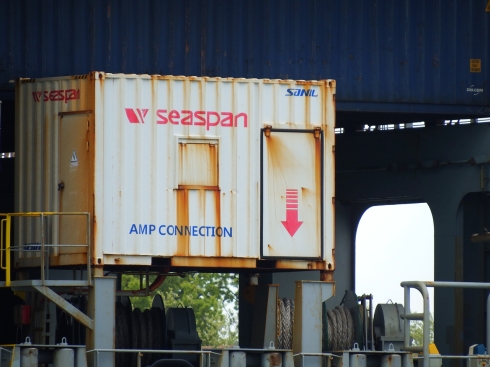The ONE Apus “dump” must have some folks wondering how containers are secured. The answer is lashing, and it is not new, but it has changed over centuries. Today’s lashing rods are an outgrowth of containerization, attempts to prevent what happened with ONE Apus and many other vessels. See the turnbuckles on the lower ends of the lashing rods, to tighten not too much but just right.

See more turnbuckles here, with the top ends connecting near the corner twist locks.
Here you see lashing rods between each of the stacks. Lashing rods bolster the twist lock connections, lower and upper corners, between containers on a stack.

Here closer up you can see the rods and the twist locks. Lashing requirements can be learned here. The gray structure below is a lashing bridge, which serves both as a platform for crew who attach the lashings and an anchor for the lashing rods. On corners of containers are interlocking cones. A short video on the hazards can be seen here.


Lashing bridges throughout the vessels can be seen clearly when a vessel carries no containers above the deck.

ACL prides itself on never having lost a container overboard because of these substantial structures between rows of containers.

Looking elsewhere around some ships, you may see a panel marked AMP. No, it’s not an amplifier for the crew rock band. AMP, alternate marine power, allows a vessel to plug into “shore power,” thereby reducing emissions in port. You may have heard of “cold ironing,” which this equipment facilitates; anyone downwind benefits from the improved air quality.

Follow the blue stack downward to see the location of this AMP panel.

Another vessel, another configuration.

A few years ago, I saw one here on Cosco Prince Rupert
port stern quarter, and also on
MOL Gratitude. I saw the first of these back in 2014 here.
And while we’re looking at details in the stern quarters, . . . check out the basket. It’s certainly not the first hoop I’ve seen on a ship. While we’re looking at this photo, check out the two roller fairleads, through which dock line is led to mitigate harmful line chafing.

All photos, WVD, who wishes you “happy looking.”






7 comments
Comments feed for this article
December 14, 2020 at 12:01 pm
John Carbone
Absolutely enlightening Tnx
“Civility is manifested not only in what we do, but in what we choose not to do.” John M. Carbone
John M. Carbone, Esq. Carbone and Faasse 401 Goffle Road Ridgewood, NJ 07450
Phone (201) 445 – 7100 FAX (201) 445 – 7520 Cell. (201) 394 – 7888 Home (973) 423 – 3157
Professional E-mail ussrecount@aol.com
>
December 14, 2020 at 12:11 pm
Lou Carreras
Thanks for the fast tutorial with links to additional material. I was looking at some photos of the dump this morning and wondered how things got stowed.
December 14, 2020 at 1:08 pm
eastriver
Good post!
December 14, 2020 at 4:22 pm
bowsprite
the whippings and lashing will continue until morale improves!
December 14, 2020 at 5:17 pm
adkscout
I can see stacking 2 layers above the lashing bridge, but to try and constrain 6 levels is insane in heavy seas. As soon as the lashing stretches and has to be retightened, there is a lot of movement and momentum. The Box corner clips just will not keep any slack out. Can’t wait for the results of the investigation.
Roll makes a lot of movement in high sea’s.
December 14, 2020 at 5:20 pm
tugster
agreed. it’ll be interesting to see what comes out of the investigation.
December 18, 2020 at 12:27 am
George Schneider
In the early days, we had “Bridge Fittings” that held the top layer boxes together. The lashers would be lowered down on the spreader, which carried a load of them, and they’d do their job. I think I’ve heard that’s no longer considered safe for the workers.
Even so, what probably killed it off was that, although containers at first weren’t standardized between companies, the height for a single company’s boxes were always the same. Once they realized they could go to extra-high boxes for lighter loads, that messed up the stacks to where bridge fittings couldn’t be applied anyway.
Too bad, too. Because in my mind they could have avoided a disaster like this.